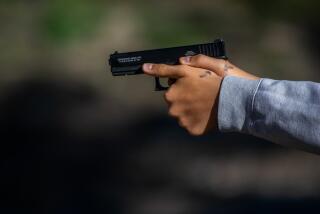Bang! A Game Befitting the Wild, Wild West
The only time I ever shot a gun, I missed the bull’s-eye. By a mile.
I had gone to Texas to report on the gun lobby’s influence in the 1994 congressional elections, and the guy
I was interviewing, a director of the National Rifle Assn., invited me out to the range. The next thing I knew, we were side by side on the desert floor outside El Paso--he wore ostrich boots and I wore wingtips--and I was cradling his trusty Springfield.
Although this brief initiation into America’s gun culture took place more than a decade ago, I still can remember the way my heart pounded and my adrenaline surged that day.
I flashed back on those feelings after reading Alex French’s engaging piece on the San Diego Dynasty, the New York Yankees of professional paintball (“War Games,” page 18). As French writes, paintball is a sport that can’t shake “the stigma of violence.” At the same time, it is enormously popular.
One report I saw on the 2005 World Series of Paintball (won by the Dynasty) noted that the event drew 40,000 people to Huntington Beach, while on the very same weekend in Los Angeles one-tenth that number turned out to protest the Iraq war.
French suggests that this fascination with paintball can be traced to America’s love affair with firearms; he quotes an MIT anthropologist who believes its origins lie in “the Wild West frontier.”
I have even less experience with a paintball gun than I do with the real deal. Still, it’s clear that this professor is on to something. Our pastimes act as a window into society at large. And America, with the highest homicide rate of any industrial democracy, is a society marked by killing.
“The frontier experience did much to set the United States on a different course” from other nations, says John Mack Faragher, a Yale historian who is studying violence in the West, which since at least the mid-1800s has been plagued (along with the South) by a relatively high incidence of murder.
Exactly how and why this legacy has unfolded are questions that Faragher and other scholars are just beginning to explore in earnest.
One factor that he cites was the migration into the region of a mostly young male population, often lonely and fueled by alcohol. Inside 19th century “saloons filled with armed men,” Faragher says, “drunks engaged in lethal duels over penny-ante gambling debts, and men pulled Colts and fired away because of disputes over the depth of the foam on a mug of beer.”
It is unfair, perhaps, to saddle the boys of the San Diego Dynasty with the charge of glorifying bloodshed. But it is also naive to think that they aren’t the perfect symbol of a civilization with a mighty quick trigger finger.


